
|
Agricultura Técnica
Instituto de Investigaciones Agropecuarias, INIA
ISSN: 0365-2807
EISSN: 0365-2807
Vol. 64, No. 3, 2004, pp. 238-244
|
 Bioline Code: at04025
Bioline Code: at04025
Full paper language: Spanish
Document type: Research Article
Document available free of charge
|
|
|
Agricultura Técnica, Vol. 64, No. 3, 2004, pp. 238-244
| es |
Efecto de aceites esenciales de lavanda y laurel sobre el Ácaro Varroa destructor Anderson & Truemann (Acari:Varroidae)
Neira, Miguel C.; Heinsohn, Paula P.; Carrillo, Roberto L.; Báez, Andrea M. & Fuentealba, Juan A.
Resumen
La varroasis es considerada la más seria enfermedad parasitaria de las abejas (Apis mellifera L.) y es provocada por el ácaro Varroa destructor Anderson & Truemann. Una gran cantidad de productos han sido probados para el control de esta enfermedad parasitaria. Actualmente se han generado razas resistentes, problemas de contaminación de la miel y de otros productos de la colmena, debido al uso indiscriminado y reiterado de algunos productos contra este ácaro. La tendencia actual es el uso de productos naturales como parte de una estrategia de control integrado. Esta investigación tuvo como objetivo evaluar los efectos de los aceites esenciales extraídos de Lavandula officinalis Chaix y Laurelia sempervirens (Ruiz et Pav.) Tul. sobre el ácaro Varroa destructor. La unidad experimental consistió en una jaula con 15 abejas, cada una parasitada con un ácaro. Se emplearon cuatro tratamientos: aceite esencial de lavanda (30%), aceite esencial de laurel (30%) acetona pura y un testigo, que recibió agua destilada. Los productos se aplicaron en la jaula, en una cámara climática, con condiciones similares a la colmena. El periodo de evaluación se extendió por 24 h, con intervalos de 1, 3, 5, 8, 14 y 24 h. Ambos aceites esenciales removieron el 100% de los ácaros, sin embargo, el porcentaje de mortalidad de los ácaros fue bajo, 41,67 y 35%, para aceite de lavanda y aceite de laurel, respectivamente.
Palabras-clave
varroa, varroasis, aceites esenciales, Lavandula officinalis, Laurelia sempervirens
|
| |
| en |
The effect of lavender and laurel essential oils on Varroa destructor Anderson & Truemann (Acari:Varroidae)
Neira, Miguel C.; Heinsohn, Paula P.; Carrillo, Roberto L.; Báez, Andrea M. & Fuentealba, Juan A.
Abstract
The varroasis is considered the most serious parasitic disease of honey bees (Apis mellifera L.); it is produced by the mite Varroa destructor Anderson & Truemann. A large number of products have been tested for the control of this parasitic disease. Currently, resistant races, problems of contamination of honey and other products of the hive have been generated by the indiscriminate and reiterated use of some products against this mite. The current tendency for its control is the utilization of natural products as part of an integrated control strategy. This investigation had the objective of evaluating the effects of essential oils, extracted from lavender (Lavandula officinalis Chaix) and laurel (Laurelia sempervirens Ruiz et Pav. Tul.) on V. destructor. The experimental unit, consisted of a cage with 15 bees, each affected by one mite. Four treatments were employed: essential oil of lavender (30%), essential oil of laurel (30%), pure acetone, and the control that received distillated water. Products were applied in the cage, in a climatic chamber, with similar conditions to the hive. The period of evaluation lasted 24 h, at intervals of 1, 3, 5, 8, 14 and 24 h. Both essential oils removed 100% of the mites, however, the percentage of mortality of the mite was low, 41.67 and 35% for lavender oil and laurel oil, respectively.
Keywords
Varroa mite, varroasis, essential oils, Lavandula officinalis, Laurelia sempervirens
|
| |
© Copyright 2004 - Instituto de Investigaciones Agropecuarias, INIA (Chile).
Alternative site location: http://www.inia.cl/at/agritec.htm
|
|
